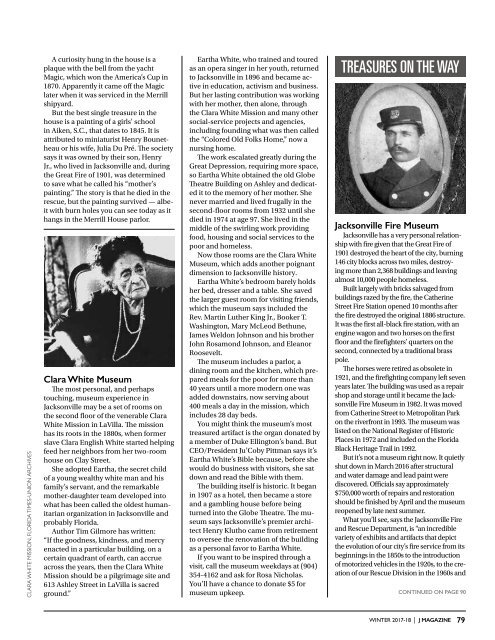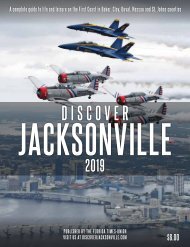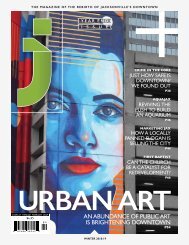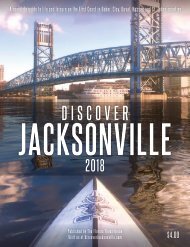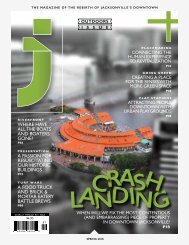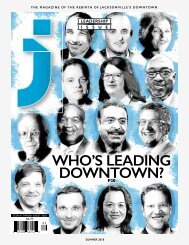J Magazine Winter 2017
The magazine of the rebirth of Jacksonville's downtown
The magazine of the rebirth of Jacksonville's downtown
Create successful ePaper yourself
Turn your PDF publications into a flip-book with our unique Google optimized e-Paper software.
Clara White Mission, FLORIDA TIMES-UNION ARCHIVES<br />
A curiosity hung in the house is a<br />
plaque with the bell from the yacht<br />
Magic, which won the America’s Cup in<br />
1870. Apparently it came off the Magic<br />
later when it was serviced in the Merrill<br />
shipyard.<br />
But the best single treasure in the<br />
house is a painting of a girls’ school<br />
in Aiken, S.C., that dates to 1845. It is<br />
attributed to miniaturist Henry Bounetheau<br />
or his wife, Julia Du Pré. The society<br />
says it was owned by their son, Henry<br />
Jr., who lived in Jacksonville and, during<br />
the Great Fire of 1901, was determined<br />
to save what he called his “mother’s<br />
painting.” The story is that he died in the<br />
rescue, but the painting survived — albeit<br />
with burn holes you can see today as it<br />
hangs in the Merrill House parlor.<br />
Clara White Museum<br />
The most personal, and perhaps<br />
touching, museum experience in<br />
Jacksonville may be a set of rooms on<br />
the second floor of the venerable Clara<br />
White Mission in LaVilla. The mission<br />
has its roots in the 1880s, when former<br />
slave Clara English White started helping<br />
feed her neighbors from her two-room<br />
house on Clay Street.<br />
She adopted Eartha, the secret child<br />
of a young wealthy white man and his<br />
family’s servant, and the remarkable<br />
mother-daughter team developed into<br />
what has been called the oldest humanitarian<br />
organization in Jacksonville and<br />
probably Florida.<br />
Author Tim Gilmore has written:<br />
“If the goodness, kindness, and mercy<br />
enacted in a particular building, on a<br />
certain quadrant of earth, can accrue<br />
across the years, then the Clara White<br />
Mission should be a pilgrimage site and<br />
613 Ashley Street in LaVilla is sacred<br />
ground.”<br />
Eartha White, who trained and toured<br />
as an opera singer in her youth, returned<br />
to Jacksonville in 1896 and became active<br />
in education, activism and business.<br />
But her lasting contribution was working<br />
with her mother, then alone, through<br />
the Clara White Mission and many other<br />
social-service projects and agencies,<br />
including founding what was then called<br />
the “Colored Old Folks Home,” now a<br />
nursing home.<br />
The work escalated greatly during the<br />
Great Depression, requiring more space,<br />
so Eartha White obtained the old Globe<br />
Theatre Building on Ashley and dedicated<br />
it to the memory of her mother. She<br />
never married and lived frugally in the<br />
second-floor rooms from 1932 until she<br />
died in 1974 at age 97. She lived in the<br />
middle of the swirling work providing<br />
food, housing and social services to the<br />
poor and homeless.<br />
Now those rooms are the Clara White<br />
Museum, which adds another poignant<br />
dimension to Jacksonville history.<br />
Eartha White’s bedroom barely holds<br />
her bed, dresser and a table. She saved<br />
the larger guest room for visiting friends,<br />
which the museum says included the<br />
Rev. Martin Luther King Jr., Booker T.<br />
Washington, Mary McLeod Bethune,<br />
James Weldon Johnson and his brother<br />
John Rosamond Johnson, and Eleanor<br />
Roosevelt.<br />
The museum includes a parlor, a<br />
dining room and the kitchen, which prepared<br />
meals for the poor for more than<br />
40 years until a more modern one was<br />
added downstairs, now serving about<br />
400 meals a day in the mission, which<br />
includes 28 day beds.<br />
You might think the museum’s most<br />
treasured artifact is the organ donated by<br />
a member of Duke Ellington’s band. But<br />
CEO/President Ju’Coby Pittman says it’s<br />
Eartha White’s Bible because, before she<br />
would do business with visitors, she sat<br />
down and read the Bible with them.<br />
The building itself is historic. It began<br />
in 1907 as a hotel, then became a store<br />
and a gambling house before being<br />
turned into the Globe Theatre. The museum<br />
says Jacksonville’s premier architect<br />
Henry Klutho came from retirement<br />
to oversee the renovation of the building<br />
as a personal favor to Eartha White.<br />
If you want to be inspired through a<br />
visit, call the museum weekdays at (904)<br />
354-4162 and ask for Rosa Nicholas.<br />
You’ll have a chance to donate $5 for<br />
museum upkeep.<br />
TREASURES ON THE WAY<br />
Jacksonville Fire Museum<br />
Jacksonville has a very personal relationship<br />
with fire given that the Great Fire of<br />
1901 destroyed the heart of the city, burning<br />
146 city blocks across two miles, destroying<br />
more than 2,368 buildings and leaving<br />
almost 10,000 people homeless.<br />
Built largely with bricks salvaged from<br />
buildings razed by the fire, the Catherine<br />
Street Fire Station opened 10 months after<br />
the fire destroyed the original 1886 structure.<br />
It was the first all-black fire station, with an<br />
engine wagon and two horses on the first<br />
floor and the firefighters’ quarters on the<br />
second, connected by a traditional brass<br />
pole.<br />
The horses were retired as obsolete in<br />
1921, and the firefighting company left seven<br />
years later. The building was used as a repair<br />
shop and storage until it became the Jacksonville<br />
Fire Museum in 1982. It was moved<br />
from Catherine Street to Metropolitan Park<br />
on the riverfront in 1993. The museum was<br />
listed on the National Register of Historic<br />
Places in 1972 and included on the Florida<br />
Black Heritage Trail in 1992.<br />
But it’s not a museum right now. It quietly<br />
shut down in March 2016 after structural<br />
and water damage and lead paint were<br />
discovered. Officials say approximately<br />
$750,000 worth of repairs and restoration<br />
should be finished by April and the museum<br />
reopened by late next summer.<br />
What you’ll see, says the Jacksonville Fire<br />
and Rescue Department, is “an incredible<br />
variety of exhibits and artifacts that depict<br />
the evolution of our city’s fire service from its<br />
beginnings in the 1850s to the introduction<br />
of motorized vehicles in the 1920s, to the creation<br />
of our Rescue Division in the 1960s and<br />
CONTINUED ON PAGE 90<br />
WINTER <strong>2017</strong>-18 | J MAGAZINE 79


